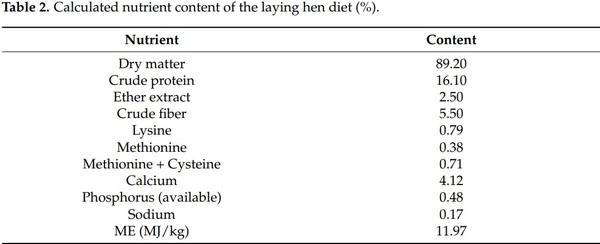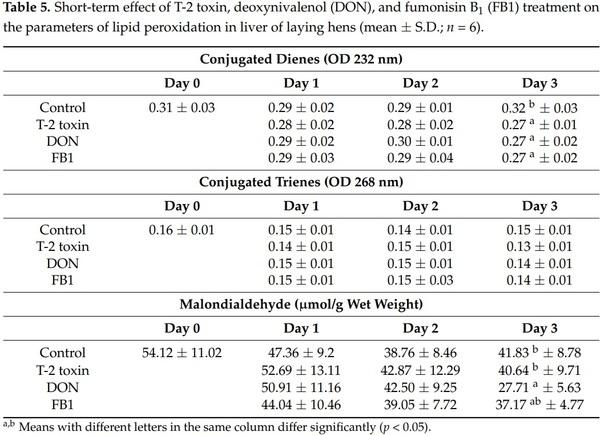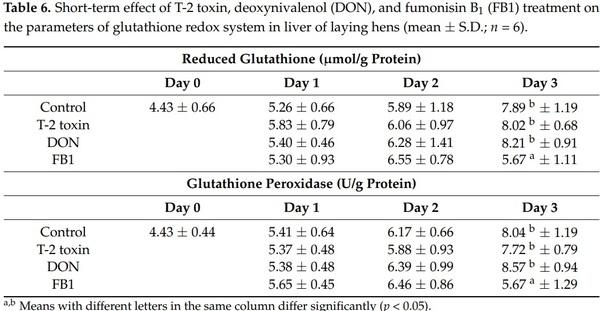Effects of Fusarium Mycotoxin Exposure on Lipid Peroxidation and Glutathione Redox System in the Liver of Laying Hens







1. Biomin. World Mycotoxin Sur. 2020. Available online: https://www.biomin.net/downloads/2020-biomin-world-mycotoxinsurvey-report (accessed on 10 July 2021).
2. Sokolovic, M.; Garaj-Vrhovac, V.; Simpraga, B. T-2 toxin incidence and toxicity in poultry. Arh. Hig. Rada. Toksikol. 2008, 59, 43–52.
[CrossRef] [PubMed]
3. Nesic, K.; Ivanovic, S.; Nesic, V. Fusarial toxins: Secondary metabolites of Fusarium fungi. Rev. Environ. Contam. Toxicol. 2014,
228, 101–120.
4. Magnoli, A.; Monge, M.; Milazzo, R.; Cavaglieri, L.; Magnoli, C.; Merkis, C.; Cristofolini, A.; Dalcero, A.; Chiacchiera, S. Effect of low levels of aflatoxin B1 on performance, biochemical parameters, and aflatoxin B1 in broiler liver tissues in the presence of monensin and sodium bentonite. Poult. Sci. 2011, 90, 48–58. [CrossRef]
5. Grenier, B.; Bracarense, A.P.F.; Schwartz, H.E.; Lucioli, J.; Cossalter, A.-M.; Moll, W.D.; Schatzmayr, G.; Oswald, I.P. Biotransformation approaches to alleviate the effects induced by Fusarium mycotoxins in swine. J. Agric. Food Chem. 2013, 61, 6711–6719.
[CrossRef]
6. Danicke, S. Prevention and control of mycotoxins in the poultry production chain: A European view. World Poult. Sci. J. 2002, 58,
451–474. [CrossRef]
7. Danicke, S.; Gareis, M.; Bauer, J. Orientation values for critical concentrations of deoxynivalenol and zearalenone in diets for pigs, ruminants and gallinaceous poultry. Proc. Soc. Nutr. Physiol. 2001, 10, 171–174.
8. Bermudez, A.J.; Ledoux, D.R.; Rottinghaus, G.E. Effects of Fusarium moniliforme culture material containing known levels of fumonisin B1 in ducklings. Avian Dis. 1995, 39, 879–886. [CrossRef] [PubMed]
9. Swanson, S.P.; Helaszek, C.; Buck, W.B.; Rood, J.H.D.; Haschek, W.M. The role of intestinal microflora in the metabolism of trichothecene mycotoxins. Food Chem. Toxicol. 1988, 26, 823–829. [CrossRef]
10. Szilágyi, M.; Fekete, S.; Huszenicza, G.Y.; Albert, M. Biochemical and physiological effects of long-term sublethal T-2 toxin feeding in rabbits. Acta. Biol. Hung. 1994, 45, 69–76.
11. Wu, Q.; Dohnal, V.; Huang, L.; Kuca, K.; Yuan, Z. Metabolic pathways of trichothecenes. Drug Metab. Rev. 2010, 42, 250–267.
[CrossRef]
12. Ehling, G.; Cockburn, A.; Snowdon, P.; Buschhaus, H. The significance of the Fusarium toxin deoxynivalenol (DON) for human and animal health. In Proceedings of the V. European Fusarium Seminar, Szeged, Hungary, 29 August–5 September 1997.
13. Holladay, S.D.; Smith, B.J.; Luster, M.I. B-lymphocyte precursor cells represent sensitive targets of T2 mycotoxin exposure. Toxicol.
Appl. Pharmacol. 1995, 131, 309–315. [CrossRef]
14. Ueno, Y.; Nakajima, M.; Sakai, K.; Ishii, K.; Sato, N.; Shimada, N. Comparative toxicity of trichothecene mycotoxins: Inhibition of protein synthesis in animal cells. J. Biochem. 1983, 74, 285–292.
15. Kidd, M.T.; Hagler, W.M.; Qureshi, M.A. Trichothecene mycotoxins depress the mononuclear-phagocytic system of young turkeys.
Immunopharmacol. Immunotoxicol. 1995, 17, 385–398. [CrossRef] [PubMed]
16. Dänicke, S.; Ueberschär, K.H.; Valenta, H.; Matthes, S.; Matthäus, K.; Halle, I. Effects of graded levels of Fusarium-toxincontaminated wheat in Pekin duck diets on performance, health and metabolism of deoxynivalenol and zearalenone. Br. Poult.
Sci. 2004, 45, 264–272. [CrossRef]
17. Harvey, R.B.; Kubena, L.F.; Huff, W.E.; Elissalde, M.H.; Phillips, T.D. Hematologic and immunologic toxicity of deoxynivalenol (DON)-contaminated diets to growing chickens. Bull. Environ. Contam. Toxicol. 1991, 46, 410–416. [CrossRef]
18. Dänicke, S.; Ueberschär, K.H.; Halle, I.; Matthes, S.; Valenta, H.; Flachowsky, G. Effect of addition of a detoxifying agent to laying hen diets containing uncontaminated or Fusarium toxin-contaminated maize on performance of hens and on carryover of zearalenone. Poult. Sci. 2002, 81, 1671–1680. [CrossRef]
19. Leathwood, P.D. Tryptophan availability and serotonin synthesis. Proc. Nutr. Soc. 1987, 46, 143–146. [CrossRef]
20. Fioramonti, J.; Dupuy, C.; Dupuy, J.; Bueno, L. The mycotoxin, deoxynivalenol, delays gastric emptying through serotonin-3 receptors in rodents. J. Pharmacol. Exp. Ther. 1993, 266, 1255–1260.
21. Leathwood Kim, M.Y.; Linardic, C.; Obeid, L.; Hannun, Y. Identification of sphingomyelin turnover as an effector mechanism for the action of tumor-necrosis-factor-alpha and gamma-interferon -specific role in cell differentiation. J. Biol. Chem. 1991, 266,
484–489.
22. Gelderblom, W.C.A.; Jaskiewicz, K.; Marasas, W.F.O.; Thiel, P.G.; Horak, R.M.; Vleggaar, R.; Kriek, N.P.J. Fumonisins—Novel mycotoxins with cancer-promoting activity produced by Fusarium moniliforme. Appl. Environ. Microbiol. 1988, 54, 1806–1811.
[CrossRef] [PubMed]
23. Guerre, P.; Eeckhoutte, C.; Burgat, V.; Galtier, P. The effects of T-2 toxin exposure on liver drug metabolising enzymes in rabbit.
Food Addict. Contam. 2000, 12, 1019–1026. [CrossRef] [PubMed]
24. Mézes, M.; Virág, G.Y.; Barta, M.; Abouzeid, A.D. Effect of lipid peroxide loading on lipid peroxidation and on the glutathione and cytochrome systems in rabbits. Acta Vet. Hung. 1996, 44, 443–450.
25. Mézes, M.; Barta, M.; Nagy, G. Comparative investigation on the effect of T-2 mycotoxin on lipid peroxidation and antioxidant status in different poultry species. Res. Vet. Sci. 1988, 66, 19–23. [CrossRef]
26. Sure, P.F.; Dvorsky, J.E.; Sparks, N.H.C.; Jaques, K.A. Impact of mycotoxins on the body’s antioxidant defence. In Nutritional
Biotechnology in the Feed and Food Industries.; Lyons, T.P., Jaques, K.A., Eds.; Nottingham University Press: Nottingham, UK, 2002; pp. 131–142.
27. Bócsai, A.; Pelyhe, C.S.; Zándoki, E.; Ancsin, Z.S.; Szabó-Fodor, J.; Erdélyi, M.; Mézes, M.; Balogh, K. Short-term effects of T-2 toxin exposure on some lipid peroxide and glutathione redox parameters of broiler chickens. J. Anim. Physiol. Anim. Nutr. 2016,
100, 520–525. [CrossRef]
28. Rezar, V.; Frankie, T.; Narat, M.; Levart, A.; Salobir, J. Dose-dependent effects of T-2 toxin on performance, lipid peroxidation, and genotoxicity in broiler chicken. Poult. Sci. 2007, 86, 1155–1160. [CrossRef]
29. Awad, W.A.; Vahjen, W.; Aschenbachv, J.R.; Zentek, J. A diet naturally contaminated with the Fusarium mycotoxin deoxynivalenol (DON) downregulates gene expression of glucose transporters in the intestine of broiler chickens. Livest. Sci. 2011, 140, 72–79.
[CrossRef]
30. Frankic, T.; Pajk, T.; Rezar, V.; Levart, A.; Salobir, J. The role of dietary nucleotides in reduction of DNA damage induced by T-2 toxin and deoxynivalenol in chicken leukocytes. Food Chem. Toxicol. 2006, 44, 1838–1844. [CrossRef]
31. Deepthi, B.V.; Somashekaraiah, R.; Rao, P.K.; Deepa, N.; Dharanesha, N.K.; Girish, K.S.; Sreenivasa, M.Y. Lactobacillus Plantarum
MYS6 ameliorates fumonisin B1 -induced hepatorenal damage in broilers. Front. Microbiol. 2017. [CrossRef]
32. Fodor, J.; Németh, M.; Kametler, L.; Pósa, R.; Kovács, M.; Horn, P. Novel methods of Fusarium toxins production for toxicological experiments. Acta Agrar. Kaposváriensis 2006, 10, 277–285.
33. Premier, L.; Piérard, J.Y.; Anselme, M.; Tangni, E.K.; Motte, J.C.; Larondelle, Y. Development and application of analytical methods for the determination of mycotoxins in organic and conventional wheat. Food Addict. Contam. 2006, 23, 1208–1218.
34. Trebstein, A.; Seefelder, W.; Lauber, U.; Humpf, H.-U. Determination of T-2 and HT-2 toxins in cereals including oats after immunoaffinity cleanup by liquid chromatography and fluorescence detection. J. Agric. Food Chem. 2008, 56, 4968–4975.
[CrossRef]
35. Shephard, G.S.; Sydenham, E.W.; Theil, P.G.; Gelderblom, W.C.A. Quantitative determination of fumonisins B1 and B1 by high-performance liquid chromatography with fluorescence detection. J. Liquid Chromatogr. 1990, 13, 2077–2087. [CrossRef]
36. European Commission. Recommendation of 17 August 2006 on the presence of deoxynivalenol, zearalenone, ochratoxin A, T-2 and HT-2 and fumonisins in products intended for animal feeding. Off. J. Eur. Union 2007, L 118M, 1111–1113.
37. AOAC. Official Methods of Analysis (28.054), 14th ed.; Association of Official Analytical Chemists: Arlington, VA, USA, 1984; 243p.
38. Botsoglou, N.A.; Fletouris, D.J.; Papageorgiou, G.E.; Vassilopoulos, V.N.; Mantis, A.J.; Trakatellis, A.G. Rapid, sensitive and specific thiobarbituric acid method for measuring lipid peroxidation in animal tissue, food and feedstuff samples. J. Agric. Food
Chem. 1994, 42, 1931–1937. [CrossRef]
39. Sedlak, J.; Lindsay, R.H. Estimation of total, protein-bound and non-protein sulfhydryl groups in tissues with Ellmann’s reagent.
Anal. Biochem. 1968, 25, 192–205. [CrossRef]
40. Lawrence, R.A.; Burk, R.F. Glutathione peroxidase activity in selenium-deficient rat liver. Biochem. Biophys. Res. Commun. 1976,
71, 952–956. [CrossRef]
41. Lowry, O.H.; Rosebrough, N.J.; Farr, A.L.; Randall, R.J. Protein measurement with the Folin phenol reagent. J. Biol. Chem. 1951,
193, 265–275. [CrossRef]
42. Yang, L.; Yu, Z.; Hou, J.; Deng, Y.; Zhou, Z.; Zhao, Z.; Cui, J. Toxicity and oxidative stress induced by T-2 toxin and HT-2 toxin in broilers and broiler hepatocytes. Food Chem. Toxicol. 2016, 87, 128–137. [CrossRef]
43. Balogh, K.; Kövesi, B.; Zándoki, E.; Kulcsár, S.Z.; Ancsin, Z.S.; Erdélyi, M.; Dobolyi, C.S.; Bata-Vidács, I.; Inotai, K.; Szekeres,
A.; et al. Effect of sterigmatocystin or aflatoxin-contaminated feed on lipid peroxidation and glutathione redox system and expression of glutathione redox system regulatory genes in broiler chicken. Antioxidants 2019, 8, 201. [CrossRef]
44. Livak, K.J.; Schmittgen, T.D. Analysis of relative gene expression data using real-time quantitative PCR and the 2(-Delta Delta
C(T)) method. Methods 2001, 25, 402–408. [CrossRef]
45. Szabó, A.; Szabó-Fodor, J.; Fébel, H.; Mézes, M.; Bajzik, G.; Kovács, M. Oral administration of fumonisin B1 and T-2 individually and in combination affects hepatic total and mitochondrial membrane lipid profile of rabbits. Acta Physiol. Hung. 2016, 103,
321–333. [CrossRef]
46. Holman, R.T. Autoxidation of fats and related substances. In Progress in Chemistry of Fats and Other Lipids; Holman, R.T., Lundberg,
W.O., Malkin, T., Eds.; Pergamon Press: London, UK, 1954; Volume 2, pp. 51–98.
47. Stockmann-Juvala, H.; Mikkola, J.; Naarala, J.; Loikkanen, J.; Elovaara, E.; Savolainen, K. Oxidative stress induced by fumonisin
B1 in continuous human and rodent neural cell cultures. Free Radic. Res. 2004, 38, 933–942. [CrossRef]








